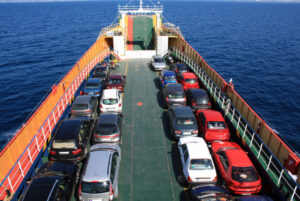Category Archives: Canada Auto Transport
How to Transport New Boats?
Transporting a new boat can be exciting, especially if it’s your first time. However, it is important that you know the proper steps to ensure your boat arrives safe and sound Canada Auto Transport.
This guide will walk you through transporting your new boat, from pre-transport inspections to final arrival inspections.
Manufacturer’s Guidelines
It is essential to follow the manufacturer’s guidelines when transporting a new boat. This information is usually available in the owner’s manual or, in some cases, online. It is important to consult the manufacturer’s guidelines for any special requirements or precautions they may suggest.
For example, some manufacturers might require you to use a specific trailer or cradle when transporting the boat. Also, they may have recommendations for what fuel to use, what type of lubricant to use, and any specific safety precautions. It is also important to check for weight restrictions as this could affect your transport method.
In addition to the manufacturer’s guidelines, it is also important to check local, state, and federal regulations regarding boat transport. This will ensure that you are not breaking any laws or regulations while transporting the boat.
Pre-Transport Inspection
It’s important to inspect your new boat thoroughly before transport. This will ensure that it’s in the best condition for the journey and ready to use when it arrives at its destination. Make sure to inspect the following areas:
- Hull: Check for signs of damage or wear and tear. You should also check the boat for stowaways, such as plants, animals, or insects.
- Engine: Ensure all fluid levels are full and the engine is in good working order Canada Auto Transport.
- Interior/Exterior: Take note of any dings, scratches, or other cosmetic damage. Make sure the interior and exterior are free of debris and there is no standing water in the boat.
- Electrical Systems: Check all wiring and connections to ensure they are in good working order.
- Accessories: Ensure that all items such as life jackets, anchors, and other accessories, are secured and in good condition.
Once your inspection is complete, you should take pictures of the boat before transport. This will provide a record of the current condition, which will be useful if any damage occurs during the transport process.
Selecting the Right Transport Method
When transporting a new boat, several options are available. The selection process should take into account the size, weight, and type of boat, as well as the destination Canada Auto Transport.
For small boats, flatbed trailers are often the best option. These trailers are designed to hold the boat in place and are usually very affordable. If you have a larger boat, a specialized cradle or trailer is recommended. These cradles and trailers are available in various sizes and configurations and can be customized to fit your boat.
In addition, you may need to hire a specialized transport service. These services usually provide enclosed trailers or flatbeds, as well as forklifts and crane services to load and unload the boat. These services are especially helpful for transporting boats to remote locations and for heavy or oversized boats.
Customized Cradles or Trailers
When transporting a new boat, it is important that the right type of trailer or cradle is used. A trailer is a good option for those who want to tow the boat themselves. It’s important to make sure that the trailer is the right size and weight rating for the boat, and that it has good tires and brakes, as well as the correct hitch. If the boat is going to be stored on a trailer, it’s important to make sure the trailer has a good winching system, and that the trailer can be secured with straps or chains.
Cradles provide a more secure transport option for larger boats. Custom cradles can be designed to fit the boat perfectly, making it more secure during transport. A custom cradle will also protect the boat from damage and can be made of various materials depending on the type of boat. These cradles can also be adjustable, so the boat can be easily loaded and unloaded Canada Auto Transport.
Securing for Transport
It’s critical to ensure that the boat is firmly secured for transport. There are various methods of securing the new boat for transport, such as ratchet straps, tie-down straps, and chains. It is important to choose the right straps for the job, as not all straps are suitable for all sizes and weights of boats. Make sure that the straps are also free from any damages which could compromise their strength.
Using the right straps, secure the boat to the trailer, making sure that all the straps are firmly in place. Secure the straps across the boat in a criss-cross pattern, with two on the bow and two on the stern. Additionally, ensure that the bow and stern straps are tied to separate parts of the trailer.
For added stability, it is recommended to add an additional safety chain to the boat. This chain should be securely fastened to the trailer, as well as to the boat itself. Make sure that the chain is as taut as possible and that it is free from any damage or kinks.
Following Transport Regulations
Transporting a new boat requires knowledge of the local and federal regulations in place. Many states have specific laws regarding the transport of boats that must be followed. It is important to be familiar with the local regulations and make sure you are in compliance.
For example, some states may require the boat to be registered even if it is brand new. Additionally, some states may require the boat to have specific lights and flags when being transported. You should always check the requirements of the states you are transporting the boat through to ensure you comply.
It is also important to consider the load limits and any permits required for heavy and oversized loads if you are transporting a large boat. The transporter is responsible for ensuring their load does not exceed the load limits of the states they are transporting through.
Finally, keep in mind the noise ordinances of the travel route and neighboring areas. Many localities have strict noise ordinances, so it is essential to research the route before transport and plan ahead to avoid any violations.
Tracking and Monitoring
When transporting a new boat, tracking and monitoring its journey is essential. This helps ensure that your boat is safe and sound during its travels. To monitor a boat’s progress, here are a few steps to take:
- Make sure that the transporter can provide you with a tracking number for the shipment. This tracking number will allow you to keep an eye on the boat’s progress across the country.
- Many transporters also offer GPS tracking services for an additional fee. This allows you to see where the boat is located at any given time during the transport.
- Additionally, many transporters offer 24-hour customer service for any questions or concerns you have throughout the process.
By tracking and monitoring your new boat’s progress, you can rest assured knowing that it’s safe and secure during its transport.
Arrival and Inspection
Once you arrive at your destination, it’s time to inspect your new boat for damages or irregularities. If you have selected a professional transport service, they should complete the inspection with you. It is important to visually inspect the entire boat, especially for any scratches, dents, and other physical damage. Additionally, check for any loose hardware, such as screws, nuts, and bolts.
Make sure to inspect the trailer or cradle for any signs of wear and tear that could have occurred during transit. Be sure to also inspect the securement cables and straps and tighten them if necessary.
For a more thorough inspection, you can hire a marine surveyor, who can check the boat, trailer, and cradle for any damages and mechanical issues. It is important to note that any damages that occurred during transport should be reported to the transport company and the manufacturer as soon as possible.
Canada Auto Transport Parting Words:
Transporting a new boat is a big responsibility that requires careful planning and preparation. Following the manufacturer’s guidelines for transport, pre-transport inspection, selecting the right transport method, and securing the boat for transport are all important steps.
Be sure to follow all transport regulations and track and monitor the shipment until it reaches its destination. When the boat arrives, inspect it thoroughly to make sure no damage occurred during transport.






